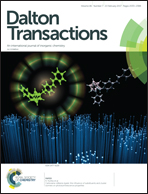Molecular interactions between Geobacter sulfurreducens triheme cytochromes and the electron acceptor Fe(iii) citrate studied by NMR†
Abstract
Proteomic and genetic studies have identified a family of five triheme cytochromes (PpcA–E) that are essential in the iron respiratory pathways of Geobacter sulfurreducens. These include the reduction of Fe(III) soluble chelated forms or Fe(III) oxides, which can be used as terminal acceptors by G. sulfurreducens. The relevance of these cytochromes in the respiratory pathways of soluble or insoluble forms of iron is quite distinct. In fact, while PpcD had a higher abundance in the Fe(III) oxides supplanted G. sulfurreducens cultures, PpcA, PpcB and PpcE were important in Fe(III) citrate supplanted cultures. Based on these observations we probed the molecular interactions between these cytochromes and Fe(III) citrate by NMR spectroscopy. NMR spectra were recorded for natural abundance and 15N-enriched PpcA, PpcB or PpcE samples at increasing amounts of Fe(III) citrate. The addition of this molecule caused pronounced perturbations on the line width of the protein's NMR signals, which were used to map the interaction region between each cytochrome and the Fe(III) citrate molecule. The perturbations on the NMR signals corresponding to the backbone NH and heme methyl substituents showed that complex interfaces consist of a well-defined patch, which surrounds the more solvent-exposed heme IV methyl groups in each cytochrome. Overall, this study provides for the first time a clear illustration of the formation of an electron transfer complex between Fe(III) citrate and G. sulfurreducens triheme cytochromes, shown to be crucial in this respiratory pathway.



 Please wait while we load your content...
Please wait while we load your content...